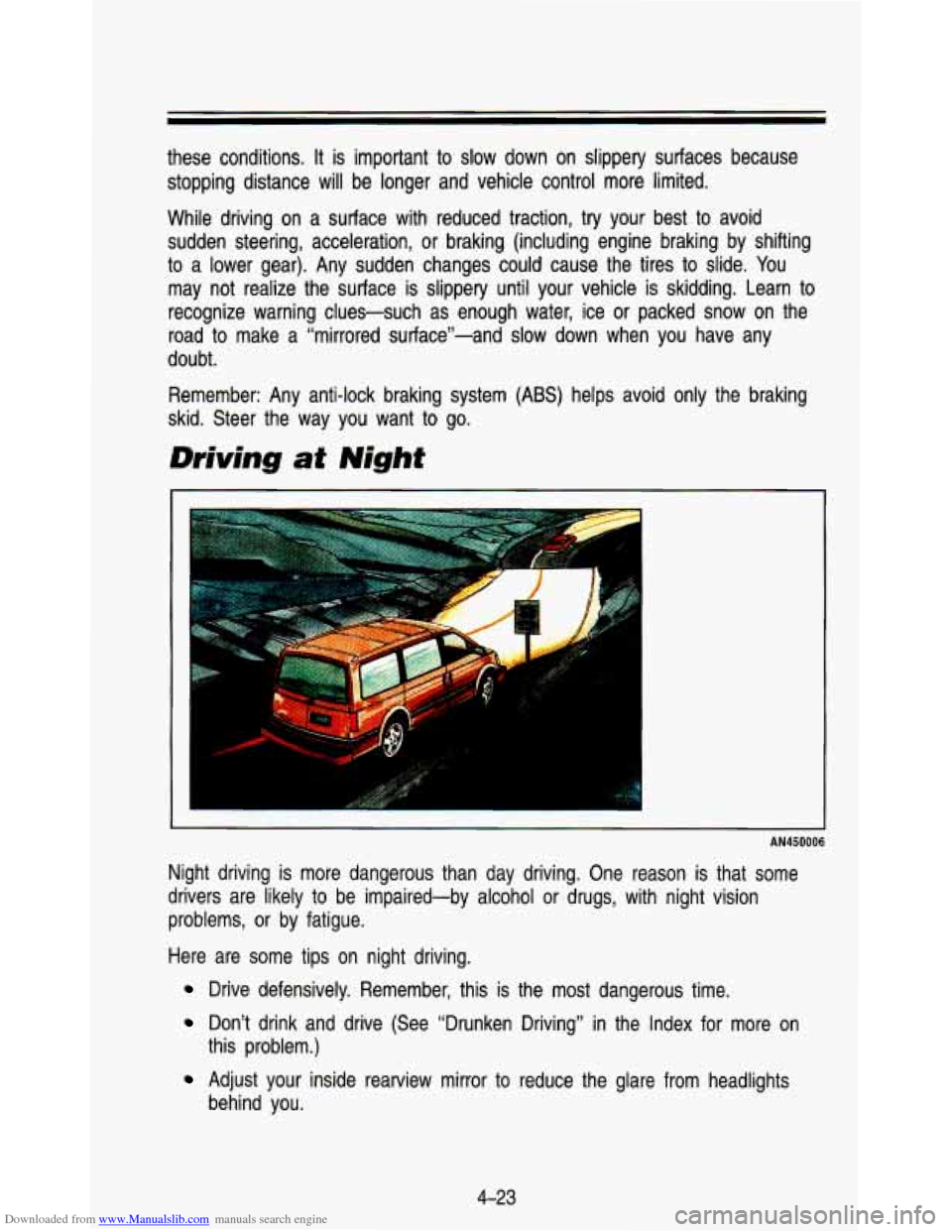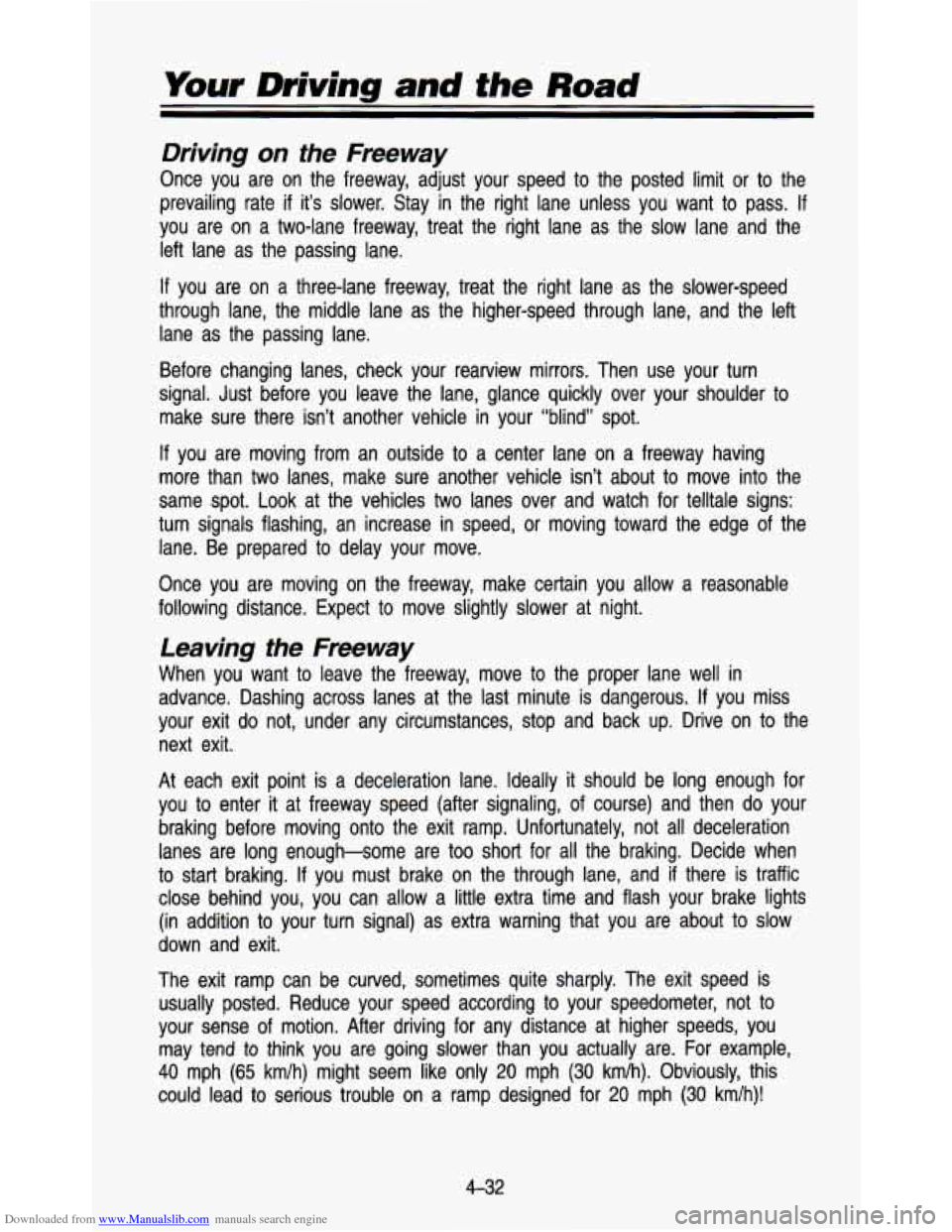1993 CHEVROLET ASTRO PASSENGER rear view mirror
[x] Cancel search: rear view mirrorPage 177 of 345

Downloaded from www.Manualslib.com manuals search engine these conditions. It is important to slow down on slippery surfaces because
stopping distance will be longer and vehicle control more limited.
While driving on a surface with reduced traction, try your best to avoid
sudden steering, acceleration, or braking (including engine brak\
ing by shifting
to a lower gear). Any sudden changes could cause the tires to s\
lide. You
may not realize the surface is slippery until your vehicle is skidding. Learn to
recognize warning clues-such as enough water, ice or packed sno\
w on the
road to make a “mirrored sutface”-and slow down when you have any\
doubt.
Remember: Any anti-lock braking system
(ABS) helps avoid only the braking
skid. Steer the way you want to go.
Driving at Night
AN450006
Night driving is more dangerous than day driving. One reason is that some
drivers are likely to be impaired-by alcohol or drugs, with night vision
problems, or by fatigue.
Here are some tips on night driving.
Drive defensively. Remember, this is the most dangerous time.
Don’t drink and drive (See “Drunken Driving” in the Index for more on
Adjust your inside rearview mirror to reduce the glare from he\
adlights
this problem.)
behind you.
4-23
Page 185 of 345

Downloaded from www.Manualslib.com manuals search engine Freeway Driving
I
P
AN461001
Mile for mile, freeways (also called thruways, parkways, expres\
sways,
turnpikes, or superhighways) are the safest of all roads. But they have their
own special rules.
The most important advice on freeway driving is: Keep up with \
traffic and
keep
to the right. Drive at the same speed most of the other drivers \
are
driving. Too-fast or too-slow driving breaks a smooth traffic
flow. Treat the left
lane on a freeway as a passing lane.
Entering the Freeway
At the entrance there is usually a ramp that leads to the freewa\
y. If you have
a clear view of the freeway as you drive along the entrance ramp, you
should begin to check traffic. Try to determine where you expect to blend
with the flow.
If traffic is light, you may have no problem. But if it is heavy,
find a gap as you move along the entering lane and time your\
approach. Try
to merge into the gap at close to the prevailing speed. Switc\
h on your turn
signal, check your rearview mirrors as you move along, and gla\
nce over your
shoulder as often as necessary.
Try to blend smoothly with the traffic flow.
4-31
Page 186 of 345

Downloaded from www.Manualslib.com manuals search engine Your Driving and the Road
Driving on the Freeway
Once you are on the freeway, adjust your speed to the posted \
limit or to the
prevailing rate
if it’s slower. Stay in the right lane unless you want to pass. If
you are on a two-lane freeway, treat the right lane as the s\
low lane and the
left lane as the passing lane.
If you are on a three-lane freeway, treat the right lane as the \
slower-speed
through lane, the middle lane as the higher-speed through lane,\
and the left lane as the passing lane.
Before changing lanes, check your rearview mirrors. Then use yo\
ur turn
signal. Just before you leave the lane, glance quickly over yo\
ur shoulder to make sure there isn’t another vehicle in your “blind” \
spot.
If you are moving from an outside to a center lane on a freeway\
having
more than two lanes, make sure another vehicle isn’t about \
to move into the
same spot. Look at the vehicles
two lanes over and watch for telltale signs:
turn signals flashing, an increase in speed, or moving toward \
the edge of the
lane. Be prepared to delay your move.
Once you are moving on the freeway, make certain you allow a \
reasonable
following distance. Expect to move slightly slower at night.
Leaving the Freeway
When you want to leave the freeway, move to the proper lane \
well in
advance. Dashing across lanes at the last minute is dangerous. \
If you miss
your exit do not, under any circumstances, stop and back up. \
Drive on to the
next exit.
At each exit point is a deceleration lane. Ideally
it should be long enough for
you to enter
it at freeway speed (after signaling, of course) and then do yo\
ur
braking before moving onto the exit ramp. Unfortunately, not al\
l deceleration
lanes are long enough-some are too short for all the braking. \
Decide when
to start braking.
If you must brake on the through lane, and if there is traffic
close behind you, you can allow a little extra time and flash\
your brake lights
(in addition to your turn signal) as extra warning that you \
are about
to slow
down and exit.
The exit ramp can be curved, sometimes quite sharply. The exit\
speed is usually posted. Reduce your speed according to your speedometer,\
not to
your sense of motion. After driving for any distance at higher\
speeds, you may tend
to think you are going slower than you actually are. For example,\
40 mph (65 km/h) might seem like only 20 mph (30 kmk). Obviously, this
could lead to serious trouble on
a ramp designed for 20 mph (30 kmlh)!
4-32
Page 188 of 345

Downloaded from www.Manualslib.com manuals search engine Your Driving and the Road
On two-lane highways or undivided multilane highways that do not have
controlled access, you’ll want to watch for some situations not usually found
on freeways. Examples are: stop signs and signals, shopping cen\
ters with
direct access to the highway, no passing zones and school zones, vehicles
turning left and right
off the road, pedestrians, cyclists, parked vehicles, and
even animals.
Highway Hypnosis
Is there actually such a condition as “highway hypnosis?’’ Or is it just plain
falling asleep at the wheel? Call it highway hypnosis, lack of awareness, or
whatever.
There is something about an easy stretch
of road with the same scenery,
along with the hum
of the tires on the road, the drone of the engine, and the
rush
of the wind against the vehicle that can make you sleepy. Don’t le\
t it
happen to you!
If it does, your vehicle can leave the road in less than a
second, and you could crash and be injured.
What can you do about highway hypnosis? First, be aware that it can
happen.
Then here are some tips:
Make sure your vehicle is well ventilated, with a comfortably cool interior.
Keep your eyes moving. Scan the road ahead and to the sides. Check
your rearview mirrors frequently and your instruments from time \
to time.
This can help you avoid a fixed stare.
Wear good sunglasses in bright light. Glare can cause drowsiness. But
don’t wear sunglasses at night. They will drastically reduce \
your overall
vision at the very time you need all the seeing power you have.
If you get sleepy, pull off the road into a rest, service, or parking area
and take a nap, get some exercise, or both. For safety, treat\
drowsiness
on the highway as an emergency.
As in any driving situation, keep pace with traffic and allow adequat\
e
following distances.
4-34